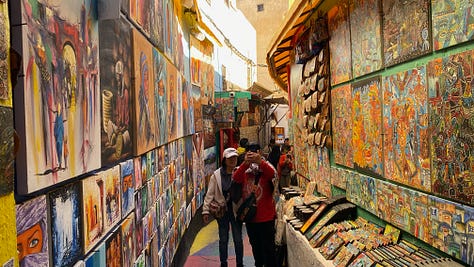End of the Moroccan trail
My six weeks in North Africa conclude with a few days in Fès before heading north to Nador for a ferry back to France via the Mediterranean
So we’re back in Morocco in this last installment of Les Périples de Peter, a look back at some of the places I explored in this ten-month adventure. Moving on from Marrakesh and Essaouira, one of my last stops in a six-week exploration of this North African paradise would take me to Fès, one of the country’s four Imperial Cities (the historic capitols of Morocco: Fès, Marrakesh, Meknes and Rabat).
Fès was the first (AD 789) and most frequent seat of Morocco’s various dynasties and boasts the largest and oldest walled city, or medina, in the country. At its heart is el-Qaraouiyyîn university, the oldest and continually operating higher education institution in the world, and it might surprise you to know it was founded by a woman, Fatima al-Fihriya, as a mosque in AD 859. (Women, however, were not allowed to study there until the 1940s.) Although I was told by my guide that non-Muslims were not allowed to enter the campus, other sites say the restriction only applies to the prayer hall. In any case, I was disappointed that my only peek at the “architectural masterpiece” came from craning my neck through an open doorway.
Fès actually has two medinas, the oldest being el-Bali and the “new” one is el-Jedid, constructed in 1276 when el-Bali had reached the physical limits of expansion within the ancient walls. Bali is the one best known to tourists and is unique not only because of its age, but because motorized conveyances are forbidden on its narrow and winding streets. Deliveries here are made on donkeys or hand-drawn carts, so there’s no need, as in Marrakesh, to be on the constant lookout for speeding motorcycles and scooters.

As I wrote back in January (You’re Going the Wrong Way), the medina can be a bit of a maze and when you are alone or looking lost, some people will try to take advantage of your naïveté. But armed with a good map or a good guide, there are hundreds of shops where you will witness craftspeople in the creation of works of art made from leathers, fabrics, common and precious metals, jewellery, wood, ceramics, etc.
I was only in Fès for three days, so didn’t see as much as I’d have liked. My overall impression was that the merchants there are more aggressive than in Marrakech or Essaouira, perhaps because the medina is so overcrowded. But the absence of vehicles is a relief, with only donkeys making asses of themselves.









My final Moroccan stopover was in the north-eastern town of Nador, on the Mediterranean coast. It’s one of two port cities from which you can catch a ferry to Europe, the other being Tangier, with its decidedly shorter one-hour route across the straight of Gibraltar to Spain. I chose Nador because I wanted to experience a two-day crossing that would land me in Sête, France.
Nador was actually a bit of a surprise, with extensive and modern boardwalk and parks along the corniche boulevard bordering the 25-km long saltwater Marchica lagoon. The lagoon is over 115 sq. km. and is a sanctuary for over 100 species of birds, including pelicans and flamingoes. The Parc ornithologique de la lagune de Marchica is a new project aimed at creating the largest bird park on the Mediterranean and help encourage a new tourism axis in northern Morocco.
The area also offers several stunning and isolated beaches, such as Charrana Beach, but since I was on foot … I stuck to the city and its bustling market. I was also treated to an entertaining free spectacle of various seabirds as I sat down for supper on the shore of the lagoon.
I was unaware at the time that if I was in the mood to visit Spain, it was actually only a few kilometres away, right beside the Beni Ansar port where I was to catch my ferry to France. Melilla is an autonomous Spanish city of just 12 sq. km. that is one of several geographic and political anomalies remaining at the end of the European colonial eras. It’s considered part of Spain but is claimed by Morocco, so is completely enclosed by border fences and heavy policing from both countries to prevent attempts by migrants to “enter Europe” and avoid the much more treacherous sea crossings. I learned about Melilla from a fellow traveller, Ebbe Munk of Denmark, on the ferry and regretted that I’d missed to opportunity to explore this rich historic and architectural jewel. You can read his photo essay here if you’d like to know more.

So Nador turned out to be mostly a site of missed opportunities for me, since I had considered it to be little more than an overnight stop on the way back to France. That’s the problem when your travels are mostly by bus and rail, there are fewer opportunities to take the road less travelled, unless it can be done on foot.
I won’t be making that mistake when I head to Sevilla, Spain, in 10 days; this time I’ll be renting a car as I explore the much-loved Andalusian territory of Spain, home to Malaga, Granada, Cadiz and Cordoba, among others. The Spanish leg of my journey will be a true road trip, with no fixed itinerary, going wherever fate or whim takes me with whomever or no one along for the ride. Does that idea make you nervous? Me too, but thankfully I’ll always have you, my readers, to keep me company.
Hasto pronto.





